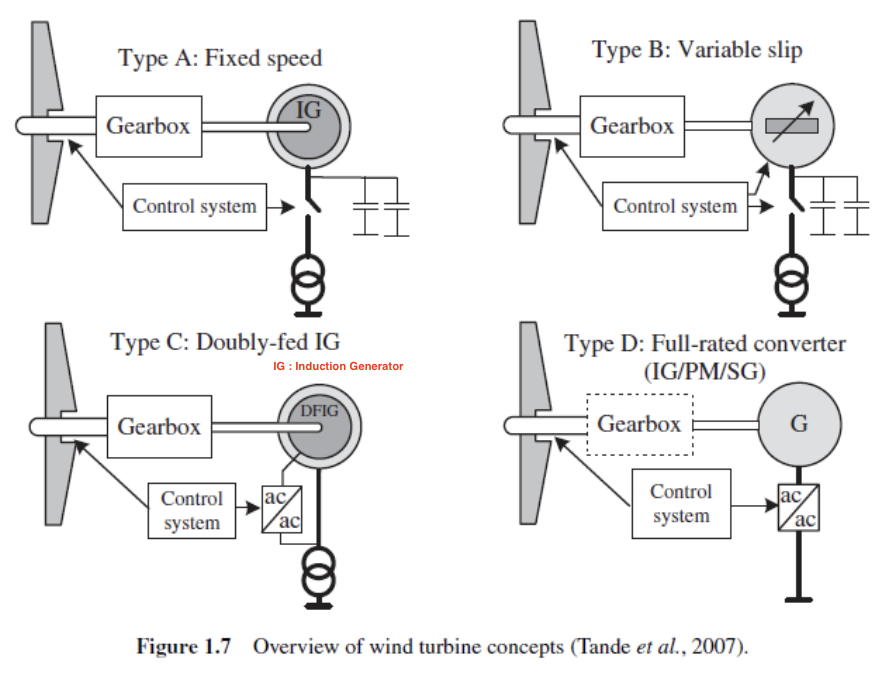
Hi everyone this is Min and I would like to share the "The overview of wind turbine concepts and output equation" from this post. I will introduce 4 types of wind turbines here and I will also mention the output equation for the wind turbine.
There are four main types of wind turbine concepts:

1. Fixed-speed wind turbine
Fixed-speed wind turbines operate at a constant speed, regardless of the wind speed. This type of wind turbine is simple and robust, but it is not as efficient as other types of wind turbines.
2. Variable-speed wind turbine
Variable-speed wind turbines can adjust their speed to match the wind speed. This makes them more efficient than fixed-speed wind turbines, but it also makes them more complex and expensive.
3. Doubly-fed induction generator (DFIG) wind turbine
DFIG wind turbines use a special type of generator that allows them to operate at variable speed. DFIG wind turbines are efficient and cost-effective and are the most common type of wind turbine used in commercial wind farms.
4. Permanent magnet synchronous generator (PMSG) wind turbine
PMSG wind turbines use a type of generator that does not require a gearbox. PMSG wind turbines are efficient and quiet, but they are more expensive than DFIG wind turbines.
The best type of wind turbine concept for a particular application will depend on a number of factors, including the wind conditions, the desired efficiency, and the budget.
Emerging wind turbine concepts
In addition to the four main types of wind turbines, there are a number of emerging wind turbine concepts. These concepts include:
- Floating wind turbines: Floating wind turbines are mounted on platforms that float in the ocean. Floating wind turbines can be used to access wind resources in deeper waters, where the wind is stronger and more consistent.
- Airborne wind turbines: Airborne wind turbines are tethered to the ground and fly in the air to capture wind energy. Airborne wind turbines can reach higher altitudes, where the wind is stronger and more consistent.
- Vertical-axis wind turbines (VAWTs): VAWTs have blades that rotate around a vertical axis. VAWTs are less noisy than HAWTs and can be placed in urban areas.
These emerging wind turbine concepts have the potential to make wind energy more efficient and cost-effective. However, they are still in the early stages of development and need to be further tested and commercialized.
The formula for the power output from a wind turbine
The power output of a wind turbine depends on a number of factors, including the wind speed, the size of the turbine's blades, and the efficiency of the turbine's generator.

The power output of a wind turbine can be calculated using the following formula:
P = 0.5 * Cp * ρ * A * V^3
where:
- P is the power output in watts (W)
- Cp is the coefficient of performance, which is a measure of the efficiency of the wind turbine
- ρ is the air density in kilograms per cubic meter (kg/m^3)
- A is the swept area of the turbine's blades in square meters (m^2)
- V is the wind speed in meters per second (m/s)
The coefficient of performance (Cp) is a measure of how well a wind turbine converts wind energy into electricity. The Cp of a wind turbine typically ranges from 0.3 to 0.5.
The air density (ρ) varies depending on the altitude and temperature. At sea level, the air density is approximately 1.225 kg/m^3.
The swept area (A) of a wind turbine's blades is the area that the blades sweep out as they rotate. The swept area of a wind turbine's blades is calculated by multiplying the radius of the blades by the length of the blades.
The wind speed (V) is the speed of the wind at the location of the wind turbine. The wind speed is a major factor in determining the power output of a wind turbine.
For example, a wind turbine with a rated power of 3 MW and a Cp of 0.4 will produce 3 MW of electricity when the wind speed is 10 m/s. However, if the wind speed drops to 5 m/s, the turbine will only produce 1.5 MW of electricity.
Wind turbines typically operate at a capacity factor of 20-40%. This means that a wind turbine will produce 20-40% of its rated power output over the course of a year. The capacity factor of a wind turbine depends on the wind conditions at the location of the turbine.
Here, I introduced the best overall formula for the power output from a wind turbine above.
I hope this will help you to upgrade your knowledge.
Min, P.E.
'003. 에너지(Power & Energy) Note' 카테고리의 다른 글
| Meaning of Surge Impedance Loading(SIL) (2) | 2023.10.17 |
|---|---|
| EMS와 SCADA의 차이점 그리고 그 특징은? (17) | 2023.10.16 |
| Types of Electrolyzers within the Hydrogen economy (26) | 2023.10.12 |
| Transmission-Line Differential equations (Telegrapher's equations) (5) | 2023.10.11 |
| 수소 경제에 대한 개념, 특징 그리고 전망 (10) | 2023.10.10 |